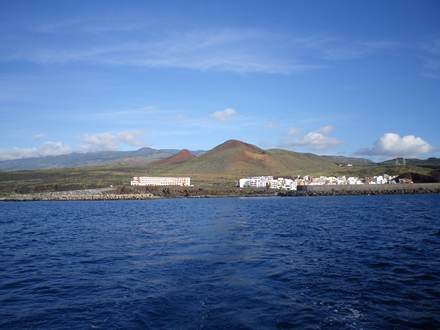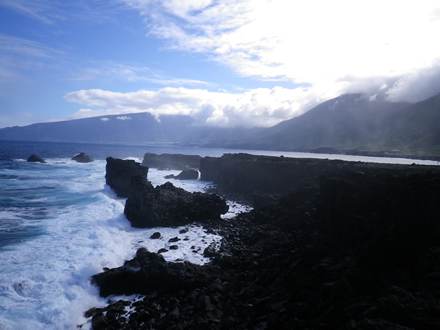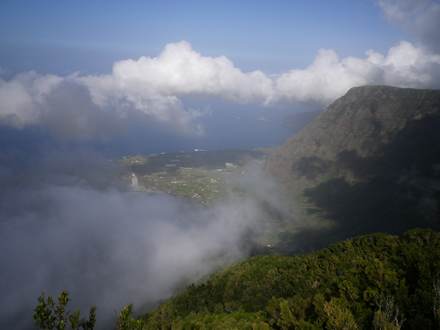El Heirro 27:38.50N 17:58.70W

Saro's Gyda
Derrick Thorrington
Sat 29 Jan 2011 19:54
The wind from San Sebastian, Gomera to El Heirro promised to be a light
northerly - just what we wanted. The passage to La Restinga on the extreme SE
point of the island was about 60 miles which, based on a slow speed of 4-5
knots, would probably take over 12 hours. The recommended place for
yachts in El Heirro is La Restinga, and this has only recently been made
possible by the addition of two large breakwaters to prevent the swell entering,
and the replacement of the fishermen's moorings with two long pontoons. Because
of this, we had no detailed charts of the entrance and so were reluctant to
enter at night. We decided to start mid afternoon, sail slowly overnight and
reach the port in daylight the following morning. This time the wind actually
stayed in the right direction (after a bit of messing about) but blew at the
wrong strength! We rolled and raced our way south, gradually reefing the mizzen,
then the main and finally taking the mizzen down in order to slow our progress.
Eventually we realised that there was no way that we would get to our
destination in the light so we hove to off the north coast of El Heirro and
spent a rolly 3 hours in the middle of the night looking at the lights of
Valverde (the main town) twinkling at us from high up the
hillside.
Our final approach was made in the early morning, rolling towards a
rather austere little town, completely isolated at the end of a black volcanic
range of hills and protected behind a vast breakwater. After much difficulty we
picked out the entrance and motored into the calm harbour.

Where is the
entrance?
La Restinga was delightful, a very quiet fishing harbour with
lots of little brightly painted fishing boats coming and going daily and
unloading their catches close by at the quay. There were only a few yachts here
and we quickly became friendly with Dieter and Claudia on their Swiss trimaran
and Brendan and Marina from Ireland. Ashore the little town seemed to be
popular with German, Norwegian and Swiss walkers and had an excellent, four
times a day, bus service from which various walks could be coordinated and
services such as post and butchers in Valverde could be accessed. The full
bus journey took about 50 mins due to the winding roads. No matter where you
went, the fare was one euro! Through this bus service we met several
other couples and became very friendly with Franz and Gerda from Germany who
were staying in a little appartment overlooking the harbour. We had such a
lovely time with Gerda, Franz, Claudia and Dieter, socialising often in the
evenings on either of the two boats or in the apartment, laughing alot and
making fun at each other's and our own race's perculiarities and
languages.

The scenery here was again very different from the other islands
already visited. The island rises almost sheer from sea level to about 1200m.
The lower and coastal scenery is very volcanic in nature whereas on the high
plain you could be forgiven in thinking that you were in the Lake District, dry
stone walls, grass, sheep, cattle and horses (although the odd prickly pear or
Aloe Vera plant might make you wonder). The top levels up to 1500m are covered
in beautiful loose Canary Pine forests, often hidden by cloud. At the
southernmost end of the island there are huge old gnarled juniper trees, a
symbol of the island, bent into arthritic shapes by the prevailing winds. All
over the island are "Miradors" with vast sweeping panoramas often over the edge
of 1000m high precipices.


The time
spent here was the usual combination of exploring by bus and foot, swimming,
snorkling and socialising but for one new and adventurous (for us) activity. We
hired a car! We took the plunge as, by bus and by walking only half of the
island could be explored. The western part is very rugged, with only one small
road, the rest being accessed by black gravel tracks winding through forests and
zigzagging up and down the steep valley sides. We had the car for 2 days at the
vast cost of 50 euros, including insurance and no excess! It was a lovely little
polo (rather newer than mine!) but despite being small, it was a bit nerve
wracking to drive along the narrow winding roads with a large drop on the
passenger side as I, particularly, found it difficult to judge the distance on
the right side of the car. (Neither had driven abroad before). Derrick, of
course, was full of useful advice and encouragement?!


As sailors, we were keen to visit the most southwesterly point of the island.
Here, close to the lonely lighthouse, was the original "0" meridian, placed here
before the New World was discovered. It was thought to be the very end of the
world. It was later moved to Greenwich.

The end of the
world

To move on to La Palma, our next island, we needed to go 65
miles north which meant that we had to keep an eye on the weather. The
winds here are predominantly from the north so that when we saw the opportunity,
we needed to go. Yesterday morning therefore, we bade farewell to our
newfound friends, having exchanged contact details and headed north towards La
Palma hoping for the predicted easterly winds.